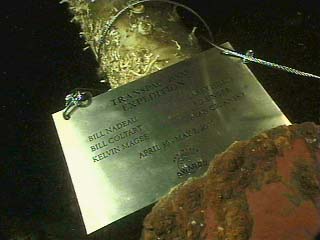Preserving Deep Technical Wrecks
- Bill Nadeau

- Sep 11, 2024
- 3 min read
Updated: Oct 15, 2024
Wreck Environment
A shipwreck, be it accidentally sunk or placed intentionally for the purpose of diving, provides a physical infrastructure which many forms of marine life become dependent on. There is also an archaeological value associated with sunken shipwrecks, such as an ongoing effort to promote a ‘no take’ policy. In many cases, these sites are preserved as marine parks or sanctuaries. Souvenir collectors have targeted some of the deeper large shipwrecks for their bells, dead-eyes and china, creating a great controversy regarding deep wreck exploration. Is the removal of artifacts and ship parts an unethical practice or should deep technical wrecks be preserved? Good question.
Honouring the historic and cultural value of shipwrecks through the placement of plaques helps promote a greater appreciation from an archaeological perspective.
Wreck environments are much less stable than cave structures. Rotting wood ribs and planks and corroded metal hulls eventually melt away in the sea. This poses a concern for wreckers, unlike the stable overhead systems in caves. Razor sharp sheet metal, broken wires and piping and a jungle of man-made materials can snag, trap and pin a wreck diver. The wreck environment requires great care when being penetrated. There is more than just an overhead ceiling to be concerned about. Many natural wrecks and some artificial reefs do not sit upright and can disorientate a diver. Like cave diving, careful planning and progressive penetration techniques must be employed.

For years, diving to 10ATA was done by very few people, as the equipment, training and know-how were scarce. Many early deep wreck pioneers dived these sites for the sole purpose of collecting souvenirs. At that time there was little thought about whether their actions were inappropriate; in fact, many recreational divers and non-divers were able to appreciate and enjoy their finds. Deep wreckers justified their collecting, asserting that these artifacts would not have been seen by anyone anyway and would eventually be either lost or destroyed as the ships dissolved and deteriorated over time. As technical diving became more of a mainstream activity, access to sites once thought purely exploratory and accessible to only a small elite group of tekkies, were now well within reach of many new divers. Archaeological groups began to lobby for better marine conservation laws with the intent of protecting these ‘grave sites’ and the history around them. Other divers wanted to be able to visit a shipwreck without having to see half of its anatomy stripped away.

For sites where lives were lost at sea, I feel it is disrespectful to strip pieces of their crypt away.
I have never been much of a souvenir collector; I already have enough junk in my garage. Even though I once admired and even envied the diehards' who explored these extreme boundaries, I now find myself supporting the campaign to preserve the environment that now possesses them, for many reasons. For sites where lives were lost at sea, I feel it is disrespectful to strip pieces of their crypt away. For the critters that have made our wrecked vessels home, I think it unfair to once again alter their environment. For future generations of extended range divers who will want to explore wrecks, I find it selfish to mutilate them for the purpose of attaining a personal memento. Yes, like many old wreck divers, I am guilty of collecting at least one piece of history, but today I think most of us have changed our opinions on the subject.
My father once asked me if I would walk around an old rotting ship if was abandoned in some junk yard or beach. I had to think about my answer as I don't actually search junk yards for old vessels. That said if there was an archaic ship in museum with a story to be told - I went to look at it. As I get older I start to lead toward the principle that divers should refrain from taking objects from deep shipwrecks. These sites hold significant historical, cultural, and ecological value. Many shipwrecks are considered underwater heritage sites, providing insight into maritime history, archaeology, and past human activity. Removing artifacts disrupts the integrity of the wreck and can lead to the loss of crucial historical context. Additionally, shipwrecks often serve as artificial reefs, supporting unique marine ecosystems. Removing objects may damage these habitats, impacting marine life. Ethical diving promotes the preservation of these sites, allowing future generations to study and enjoy them without causing harm.
It may be a goofy little ecological ditty but it is a good practice to follow: Leave only bubbles and take only pictures.







Comments